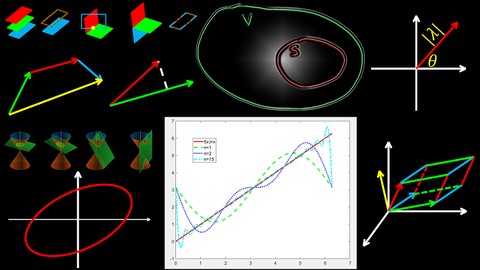Master Linear Algebra (Matrices, Vector Spaces, Numerical)

- Description
- Curriculum
- Reviews
This course is designed to make learning Linear Algebra easy. It is well-arranged into targeted sections of focused lectures and extensive worked examples to give you a solid foundation in the key topics from theory to applications.The course is ideal for:Linear algebra students who want to be at the top of their classAny person who is interested in mathematics and/or needs a refresher courseAny person who is undertaking a discipline that requires linear algebra, including science, physics and engineering, graphics and games programming, finite element analysis, machine learning, big data analysis, economics, finance and so onAt the end of this course, you will have a strong foundation in one of the most disciplines in Applied Mathematics, which you will definitely come across if you are from a science, computer science, engineering, economics or finance background. I welcome any questions and provide a friendly Q & A forum where I aim to respond to you in a timely manner. Enrol today and you will get:Lifetime access to refer back to the course whenever you need toFriendly Q & A forumUdemy Certificate of Completion30-day money back guaranteeThe course covers the following core units and topics of Linear Algebra:1) Systems of Linear Equations and Matricesa) Introduction to linear equations and general form of linear systemsb) Solutions to linear systems with two or three unknownsc) Augmented matrices and row operationsd) Row echelon formse) Gauss-Jordan vs Gaussian elimination (with back substitution)f) Homogeneous linear systemsg) Matrix and vector notation, size, and matrix operationsh) Partitioned matricesi) Inverse of a matrix or product of matrices and solving linear systems by matrix inversionj) Diagonal, triangular and symmetric matrices, and their inverse, transpose and powers2) Matrix Determinants and Inversea) Determinant of a matrix using minor matrices and Gaussian eliminationb) Computing the inverse of a matrix using the adjoint matrixc) Cramer’s rule3) Extending Vectors from 3-Space to n-Spacea) Vectors in 2D and 3D spaceb) Vectors in n-spacec) Norm of a vector in n-space and the standard unit vectorsd) Dot product in n-spacee) Orthogonality and projection using the dot productf) Cross product, scalar triple product, area and volume4) Real Vector Spacesa) Real vector spacesb) Vector subspaces, span, linear combinationsc) Linearly independent vectors and linear independenced) Basis for a vector space and coordinate vectorse) Dimension of a vector spacef) Change of basis, coordinate vectors, mapping and transition matrix5) Fundamental Matrix Spacesa) Row, column and null spaceb) Consistency of linear systems and superposition of solutionsc) Effect of row operations on row, column and null spaced) Basis for row and column spacee) Rank and nullity of a matrixf) Overdetermined and underdetermined systemsg) Fundamental matrix spacesh) Orthogonal complements6) Matrix Transformations, Operatorsa) Matrix transformations and their propertiesb) Finding standard matricesc) Operators, including projection, reflection, rotation and sheard) Compositions of matrix transformationse) One-to-one transformations and the inverse of a matrix operator7) Eigenvalues and Eigenvectors, Complex Vector Spacesa) Eigenvalues, eigenvectors and eigenspacesb) Similar matrices and diagonalisationc) Complex vector spaces, eigenvalues, eigenvectors and Euclidean inner product8) Inner Product Spacesa) Inner product spaces, norm and distance, matrix inner productsb) Orthogonalityc) Gram-Schmidt process for finding an orthonormal basis from an orthogonal set9) Orthogonal Diagonalisation, Symmetric Matrices and Quadratic Formsa) Orthogonal matricesb) Orthogonal diagonalisation and spectral decompositionc) Quadratic forms, conic sections, positive definitenessd) Conjugate transpose, diagonalisation of Hermitian and unitary matrices10) Numerical Methodsa) LU and LDU decomposition or factorisationb) Power method for estimating eigenvalues and eigenvectors using iterationc) Least squares approximationd) Singular value decompositione) QR decompositionf) Gauss-Seidel and Jacobi iteration11) Applicationsa) Balancing chemical equationsb) Approximating integrals by polynomial interpolationc) Solving linear systems of ODEs by diagonalisationd) Linear regression using the least squares methode) Approximating functions using the least squares method and Fourier series

External Links May Contain Affiliate Links read more




